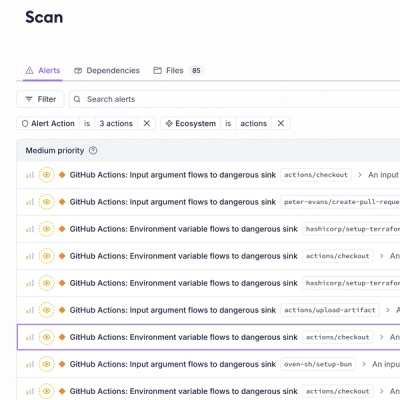
Product
Introducing Socket Firewall Enterprise: Flexible, Configurable Protection for Modern Package Ecosystems
Socket Firewall Enterprise is now available with flexible deployment, configurable policies, and expanded language support.
blockchainid
Advanced tools
A blockchain ID = a name + a blockchain ID
Let's say you register the username 'alice' within the 'id' namespace, the default namespace for usernames. Then your username would be expressed as alice.id.
Profile schema is taken from schema.org. The schema for a person record can be found at http://schema.org/Person. There are some fields that have yet to be included, like the "account", "key", "policy", "id", and "publicKey" fields. An updated schema definition will be published to a different location that superclasses the schema.org Person definition and adds these fields.
{
"name": "Alice Smith",
"accounts": []
}
Blockchain ID profiles are stored in two files: a token file and a zone file:
An identity lookup is performed as follows:
A zone file contains an origin (the name registered), a TTL (not yet supported), and a list of records.
Each record has a name, class, type, data, and checksums.
If the value of the "name" field is "@", that means the record corresponds to the "zone origin" of the name.
The "class" field corresponds to the namespace of the record's information. In ICANN DNS, this is traditionally "IN" for Internet, but this field could be changed to something else to indicate that the names are registered in a parallel DNS universe.
The "type" field indicates how the record should be resolved. Only "CNAME" is currently supported. This means that the name record should be interpreted as an alias of the URL that is provided in the "data" field.
The "data" field is interpretted in different ways, depending on the value in the "type" field. As mentioned previously, though, the only supported type at the moment is "CNAME", so the "data" field will contain a URL until that changes.
The "checksums" field indicates values in the parsed profile that should be considered "immutable" fields. One can be certain that the values of these fields cannot change because the values of their hashes must correspond to the corresponding values in the checksum records.
The "publicKeychain" field indicates the keychain that was used to sign the tokens found in the token file.
{
"origin": "alice.id",
"ttl": "1h",
"records": [
]
}
The token file contains a list of token records.
Each record contains the encoded token, a "data" field with the decoded token, a "chainPath" that indicates how to get from the master public keychain to the signing public key, and an "encrypted" field that indicates whether or not the token is encrypted.
To validate each identity token, first decode the token and grab the public key of the issuer. Then, verify the token's signature with the public key. Then check to make sure you can derive the public key from the master public keychain using the chain path. If these checks pass, the token is valid.
Each token in the token file has a header, a payload, and a signature. The payload is the important part. Each payload contains a "claim", a "subject", and an "issuer". The claim is the signed bit of information that goes into the construction of the profile. The subject references the identity that the claim is about. The issuer is the identity that is signing the token (and thus making a claim about the subject).
In the case of self-attested profile information, the subject and the issuer are the same person (one is making a statement about one's self).
However, this can be extended to any statement made by any issuer about any other subject. For example, you can sign a statement attesting to your own birth date, and then your state DMV or bank can sign a statement making the same attestation about your birth date. Then, you can present those two signed statements to any other party and present proof of your birth date.
The cool part is that the identities referenced are public keys, not usernames. That means that you can present signed tokens to a party that show proof of your birth date, all without revealing your username and thus your identity. This process is known as selective disclosure of identity information.
[
{
"token": "eyJ0eXAiOiJKV1QiLCJhbGciOiJFUzI1NiJ9.eyJjbGFpbSI6eyJuYW1lIjoiUnlhbiBTaGVhIiwiZ2l2ZW5OYW1lIjoiUnlhbiIsImZhbWlseU5hbWUiOiJTaGVhIn0sInN1YmplY3QiOnsiQHR5cGUiOiJQZXJzb24iLCJwdWJsaWNLZXkiOiIwM2QzOWI2YzM5NzEwOWFmYTNhZTE4NDRiMjEzMjE1NmE0YmYyMzYxN2ZlOTEzMmYwZmFjYzM4Y2NmOTQ1MmVhODYifSwiaXNzdWVyIjp7IkB0eXBlIjoiUGVyc29uIiwicHVibGljS2V5IjoiMDNkMzliNmMzOTcxMDlhZmEzYWUxODQ0YjIxMzIxNTZhNGJmMjM2MTdmZTkxMzJmMGZhY2MzOGNjZjk0NTJlYTg2In19.Wqo7GlyisTMRm7xQz98XBp4y_QDTTEQwhtnnoBxsXODupYJlj758rMQEFom2mU5p-WzJwWY8leHgWhoyKa4mXA",
"data": {
},
"chainPath": "9eace0988a7583d45c99ea0058b2687282ebbe4a2862c86aa0e2ed576cd1b49f",
"encrypted": false
},
]
var BlockchainID = require('blockchainid').BlockchainID,
PrivateKeychain = require('keychain-manager').PrivateKeychain,
PublicKeychain = require('keychain-manager').PublicKeychain
var privateKeychain = new PrivateKeychain(),
publicKeychain = privateKeychain.publicKeychain()
var profile = {
"@type": "Person",
"givenName": "Satoshi",
"familyName": "Nakamoto",
"knows": [
{
"@type": "Person",
"id": "gavinandresen.id"
}
]
}
var blockchainID = new BlockchainID('satoshinakamoto.id', profile)
var zoneFile = blockchainID.zoneFile(publicKeychain, hostUrls, checksums)
var tokenFile = blockchainID.signTokens(privateKeychain)
var loadedBlockchainID = BlockchainID.fromTokens('satoshinakamoto.id', tokenFile, publicKeychain)
var profile = loadedBlockchainID.profile()
console.log(profile)
{
"@type": "Person",
"givenName": "Satoshi",
"familyName": "Nakamoto",
"knows": [
{
"@type": "Person",
"id": "gavinandresen.id"
}
]
}
FAQs
Blockchain ID profile generator
We found that blockchainid demonstrated a not healthy version release cadence and project activity because the last version was released a year ago. It has 1 open source maintainer collaborating on the project.
Did you know?

Socket for GitHub automatically highlights issues in each pull request and monitors the health of all your open source dependencies. Discover the contents of your packages and block harmful activity before you install or update your dependencies.

Product
Socket Firewall Enterprise is now available with flexible deployment, configurable policies, and expanded language support.

Security News
Open source dashboard CNAPulse tracks CVE Numbering Authorities’ publishing activity, highlighting trends and transparency across the CVE ecosystem.

Product
Detect malware, unsafe data flows, and license issues in GitHub Actions with Socket’s new workflow scanning support.